Spain's new government vows to exhume Franco
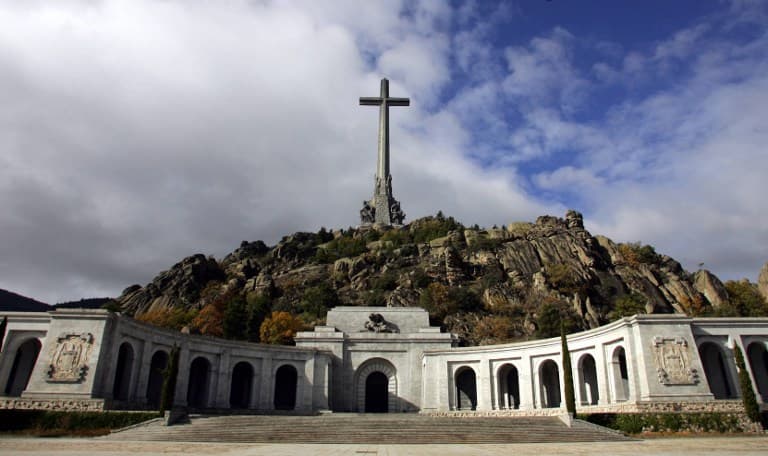
Spain's new Socialist government is determined to remove the remains of Francisco Franco from a vast mausoleum near Madrid and turn it into a place of "reconciliation" for a country still coming to terms with the dictator's legacy.
"We don't have a date yet, but the government will do it," Prime Minister Pedro Sanchez said late Monday during his first television interview since being sworn in on June 2nd after toppling his conservative predecessor Mariano Rajoy in a confidence vote.
? @sanchezcastejon, sobre la posible exhumación de los restos de Franco: "Después de 40 años, este debate nos tiene que llevar a una reflexión muy simple: España no se puede permitir símbolos que separen a españoles" https://t.co/IyLdS7Zyzx
? #PedroSánchezTVE pic.twitter.com/RSuVHqW4rD
— Telediarios de TVE (@telediario_tve) June 18, 2018
His statement is the first sign that the Socialist government will follow through on a non-binding motion proposed by the PSOE last May that called for Franco’s remains to be exhumed from the Valley of the Fallen.
"Spain can't allow symbols that divide Spaniards. Something that is unimaginable in Germany or Italy, countries that also suffered fascist dictatorships, should also not be imaginable in our country," Sanchez added.
But will this actually result in the exhumation of Spain’s most controversial leader?
The Local takes a look at the issue:
What exactly is the Valley of the Fallen?
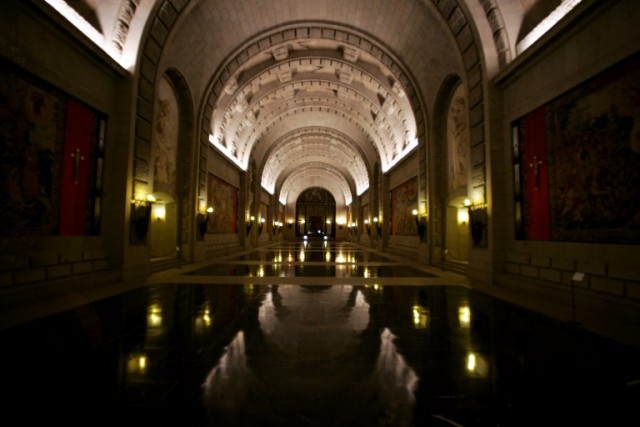 The basillica was hewn out of the living rock by Republican prisoners. Photo: AFP
The basillica was hewn out of the living rock by Republican prisoners. Photo: AFP
It is a huge basilica carved out of the living rock on a hillside 50km (30 miles) northwest of Madrid. The complex in the Guadarama hills is spread out over 13.6 square kilometres and is surrounded by pine forests. It includes a colossal esplanade leading to the colonnades and the entrance to the basilica.
It’s eerie interior is reached through airport-style security gates past a “museum shop” into a vast vaulted and domed space with black marble floors and walls lined with faded apocalyptic tapestries. Helmeted militaristic statues keep a watchful eye over worshippers and sword-bearing angels stand sentry to chapels dedicated to the armed forces.
The complex also includes a Benedictine abbey and the monks are still responsible for maintaining the site. Mass is held on Sundays.
A giant granite cross, reaching a height of 150 meters (500 ft) crowns the complex and is visible for miles on a clear day from vantage points in the capital.
Who is buried there?
.jpg)
Franco's tomb is always laid with fresh flowers. Photo: AFP
In the centre of the basilica either side of the altar and beneath a gold mosaic dome illustrated with scenes from the Bible are two tombs; that of General Francisco Franco and Jose Antonio Primo de Rivera, the founder of the fascist Spanish Falange party.
Freshly cut flowers are always to be found laid atop each tombstone.
Crypts on either side contain the remains of an estimated 50,000 people who were killed in the Spanish Civil War, including those of Republican supporters whose corpses were dug up after the conflict and added in order to fill the huge crypt.
Who built it?
On April 1st, 1940, a year after the end of the Civil War, General Franco announced plans for the Valle de los Caidos (Valley of the Fallen), a project to establish “a place of rest and meditation to perpetuate the memory of those who fell in our glorious Crusade.”
Pedro Muguriza, one of the leading Spanish architects of the time was charged with the design, and he enlisted Diego Méndez to assist.
Republican prisoners were drafted in to dig the site out of the granite mountainside where they lived in work camp conditions on site. Many died during construction before it was finally completed in 1958. Estimates range from 15 (according to regime officials) to 27,000.
Who goes there?
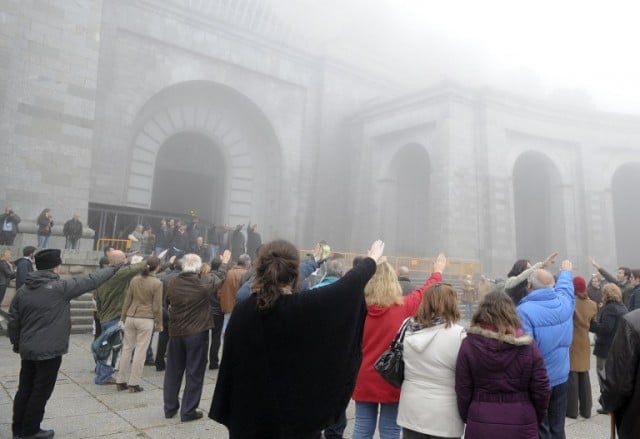
Supporters gather at the Valley of the Fallen in 2012 to honour Franco with the fascist salute on the anniversary of his death. Photo: AFP
Each year on November 20th the Francisco Franco Foundation has organized a mass to commemorate the anniversary of the death of dictator in 1975. The site has served as a rallying point for supporters of Franco and neo-fascist groups, although such displays are now outlawed under the Historical Memory Law (of which more later).
Apart from die-hard fascists and those wishing to pay their respects to the late Generalissimo, the site is also popular with tour groups with coach loads arriving each day after visiting the nearby San Lorenzo de El Escorial.
The site attracts around 240,000 visitors each year, making it one of the top tourist attractions in the Madrid region and the fourth most visited site managed by Spain’s National Heritage Trust.
Many of those whose relatives died fighting Francoist forces swear never to set foot there.
Why the controversy?
Well, aside from the fact that it was built by the slave labour of those who opposed the regime and contains the unidentified remains of tens of thousands of those killed by Francoist forces during the Civil War, now lying jumbled up alongside the remains of those they opposed, such a memorial is arguably against the law.
The Historical Memory Law, introduced in 2007 under the socialist government of Jose Luis Rodriguez Zapatero in an attempt to heal the wounds of the past, banned public symbols that honoured the dictator and his supporters.
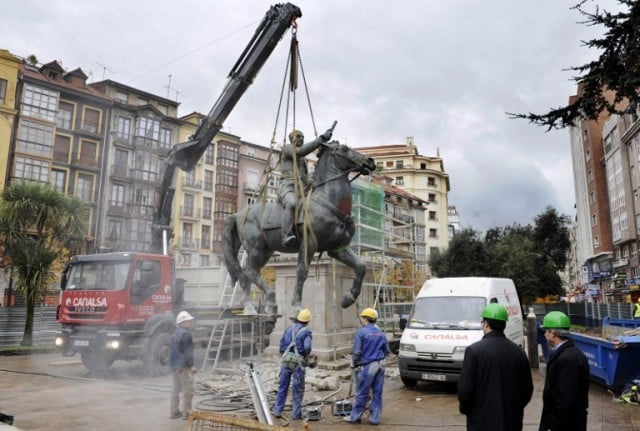
This statue of Franco was removed from the city of Santander in 2008. Photo: AFP
While street names have been changed and statues of Franco removed from public squares, the most symbolic memorial of the era has remained untouched.
READ MORE: Madrid banishes ghost of Franco from its streets with name changes.
But victims' associations say the continued existence of the memorial is "an insult to modern democratic Spain”. At the very least, Franco should be dug up and removed from the site, they say.
Some have called for the entire site to be blown up while others insist it would be enough if it was transformed into a centre for reconciliation that provided an accurate account of its history.
"We believe that the State is subjecting the dictatorship's victims to a form of mistreatment and humiliation by obligating them to pay through their taxes for dictator Francisco Franco's tomb, which is sustained through public funds," the Association for the Recovery of Historical Memory (ARMH) has told The Local.
What next?
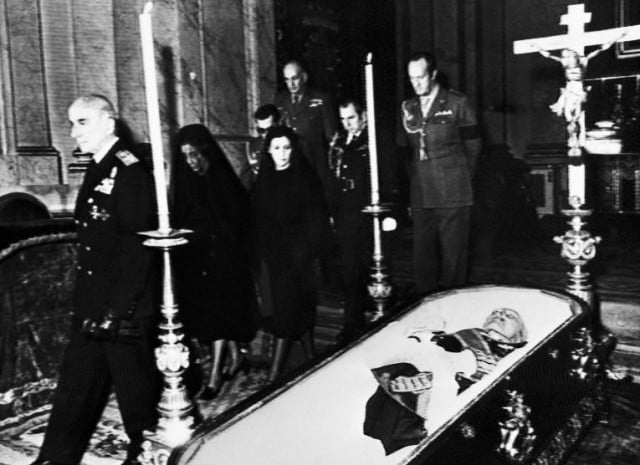
Dictator Francisco Franco in his open coffin after his death on 20 November 1979. Photo: AFP
Socialist party spokesman Oscar Puente said on Monday that the mausoleum should be transformed into a "place of reconciliation, of memory, for all Spaniards, and not of apology for the dictatorship."
The Socialists included the removal of Franco and Rivera's remains in a proposed law they presented in December 2017 when they were in opposition.
The proposed law also called for the creation of a truth commission and for politically motivated court rulings taken during Franco's dictatorship to be annulled.
Sanchez unveiled it at a highly symbolic spot near the eastern port of Valencia where more than 2,000 Republican supporters are believed to have been shot dead by Franco's forces.
"If we ignored an uncomfortable past, we can't build a comfortable future," he said at the time.
Only the conservative Popular Party has consistently blocked moves to tackle the Valley of the Fallen but the proposal will likely win enough support in Parliament to pass into law this time.
Centrist party Ciudadanos said it was open to moving Franco's remains, while anti-establishment party Podemos, which supported the no-confidence motion that brought the Socialists to power, hailed the initiative.
Top Podemos official Pablo Echenique said it was wrong for the remains of a genocidal dictator" to rest "in a giant mausoleum while there are tens of thousands of dead in mass graves".
READ MORE: Spain begins to exhume bodies from Valley of the Fallen
Comments
See Also
"We don't have a date yet, but the government will do it," Prime Minister Pedro Sanchez said late Monday during his first television interview since being sworn in on June 2nd after toppling his conservative predecessor Mariano Rajoy in a confidence vote.
? @sanchezcastejon, sobre la posible exhumación de los restos de Franco: "Después de 40 años, este debate nos tiene que llevar a una reflexión muy simple: España no se puede permitir símbolos que separen a españoles" https://t.co/IyLdS7Zyzx
— Telediarios de TVE (@telediario_tve) June 18, 2018
? #PedroSánchezTVE pic.twitter.com/RSuVHqW4rD
His statement is the first sign that the Socialist government will follow through on a non-binding motion proposed by the PSOE last May that called for Franco’s remains to be exhumed from the Valley of the Fallen.
"Spain can't allow symbols that divide Spaniards. Something that is unimaginable in Germany or Italy, countries that also suffered fascist dictatorships, should also not be imaginable in our country," Sanchez added.
But will this actually result in the exhumation of Spain’s most controversial leader?
The Local takes a look at the issue:
What exactly is the Valley of the Fallen?
 The basillica was hewn out of the living rock by Republican prisoners. Photo: AFP
The basillica was hewn out of the living rock by Republican prisoners. Photo: AFP
It is a huge basilica carved out of the living rock on a hillside 50km (30 miles) northwest of Madrid. The complex in the Guadarama hills is spread out over 13.6 square kilometres and is surrounded by pine forests. It includes a colossal esplanade leading to the colonnades and the entrance to the basilica.
It’s eerie interior is reached through airport-style security gates past a “museum shop” into a vast vaulted and domed space with black marble floors and walls lined with faded apocalyptic tapestries. Helmeted militaristic statues keep a watchful eye over worshippers and sword-bearing angels stand sentry to chapels dedicated to the armed forces.
The complex also includes a Benedictine abbey and the monks are still responsible for maintaining the site. Mass is held on Sundays.
A giant granite cross, reaching a height of 150 meters (500 ft) crowns the complex and is visible for miles on a clear day from vantage points in the capital.
Who is buried there?
.jpg)
Franco's tomb is always laid with fresh flowers. Photo: AFP
In the centre of the basilica either side of the altar and beneath a gold mosaic dome illustrated with scenes from the Bible are two tombs; that of General Francisco Franco and Jose Antonio Primo de Rivera, the founder of the fascist Spanish Falange party.
Freshly cut flowers are always to be found laid atop each tombstone.
Crypts on either side contain the remains of an estimated 50,000 people who were killed in the Spanish Civil War, including those of Republican supporters whose corpses were dug up after the conflict and added in order to fill the huge crypt.
Who built it?
On April 1st, 1940, a year after the end of the Civil War, General Franco announced plans for the Valle de los Caidos (Valley of the Fallen), a project to establish “a place of rest and meditation to perpetuate the memory of those who fell in our glorious Crusade.”
Pedro Muguriza, one of the leading Spanish architects of the time was charged with the design, and he enlisted Diego Méndez to assist.
Republican prisoners were drafted in to dig the site out of the granite mountainside where they lived in work camp conditions on site. Many died during construction before it was finally completed in 1958. Estimates range from 15 (according to regime officials) to 27,000.
Who goes there?

Supporters gather at the Valley of the Fallen in 2012 to honour Franco with the fascist salute on the anniversary of his death. Photo: AFP
Each year on November 20th the Francisco Franco Foundation has organized a mass to commemorate the anniversary of the death of dictator in 1975. The site has served as a rallying point for supporters of Franco and neo-fascist groups, although such displays are now outlawed under the Historical Memory Law (of which more later).
Apart from die-hard fascists and those wishing to pay their respects to the late Generalissimo, the site is also popular with tour groups with coach loads arriving each day after visiting the nearby San Lorenzo de El Escorial.
The site attracts around 240,000 visitors each year, making it one of the top tourist attractions in the Madrid region and the fourth most visited site managed by Spain’s National Heritage Trust.
Many of those whose relatives died fighting Francoist forces swear never to set foot there.
Why the controversy?
Well, aside from the fact that it was built by the slave labour of those who opposed the regime and contains the unidentified remains of tens of thousands of those killed by Francoist forces during the Civil War, now lying jumbled up alongside the remains of those they opposed, such a memorial is arguably against the law.
The Historical Memory Law, introduced in 2007 under the socialist government of Jose Luis Rodriguez Zapatero in an attempt to heal the wounds of the past, banned public symbols that honoured the dictator and his supporters.

This statue of Franco was removed from the city of Santander in 2008. Photo: AFP
While street names have been changed and statues of Franco removed from public squares, the most symbolic memorial of the era has remained untouched.
READ MORE: Madrid banishes ghost of Franco from its streets with name changes.
But victims' associations say the continued existence of the memorial is "an insult to modern democratic Spain”. At the very least, Franco should be dug up and removed from the site, they say.
Some have called for the entire site to be blown up while others insist it would be enough if it was transformed into a centre for reconciliation that provided an accurate account of its history.
"We believe that the State is subjecting the dictatorship's victims to a form of mistreatment and humiliation by obligating them to pay through their taxes for dictator Francisco Franco's tomb, which is sustained through public funds," the Association for the Recovery of Historical Memory (ARMH) has told The Local.
What next?

Dictator Francisco Franco in his open coffin after his death on 20 November 1979. Photo: AFP
Socialist party spokesman Oscar Puente said on Monday that the mausoleum should be transformed into a "place of reconciliation, of memory, for all Spaniards, and not of apology for the dictatorship."
The Socialists included the removal of Franco and Rivera's remains in a proposed law they presented in December 2017 when they were in opposition.
The proposed law also called for the creation of a truth commission and for politically motivated court rulings taken during Franco's dictatorship to be annulled.
Sanchez unveiled it at a highly symbolic spot near the eastern port of Valencia where more than 2,000 Republican supporters are believed to have been shot dead by Franco's forces.
"If we ignored an uncomfortable past, we can't build a comfortable future," he said at the time.
Only the conservative Popular Party has consistently blocked moves to tackle the Valley of the Fallen but the proposal will likely win enough support in Parliament to pass into law this time.
Centrist party Ciudadanos said it was open to moving Franco's remains, while anti-establishment party Podemos, which supported the no-confidence motion that brought the Socialists to power, hailed the initiative.
Top Podemos official Pablo Echenique said it was wrong for the remains of a genocidal dictator" to rest "in a giant mausoleum while there are tens of thousands of dead in mass graves".
READ MORE: Spain begins to exhume bodies from Valley of the Fallen
Join the conversation in our comments section below. Share your own views and experience and if you have a question or suggestion for our journalists then email us at [email protected].
Please keep comments civil, constructive and on topic – and make sure to read our terms of use before getting involved.
Please log in here to leave a comment.